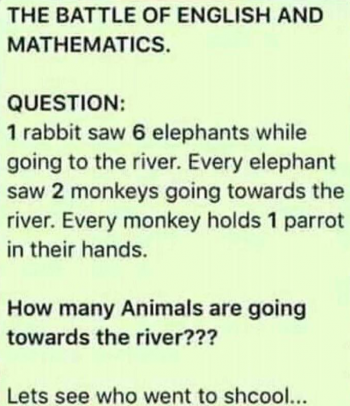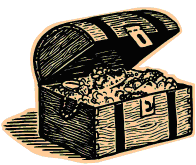Ask Professor Puzzler
Do you have a question you would like to ask Professor Puzzler? Click here to ask your question!
Navya asks: "Why do we have names for numbers?"
There are two answers to this question. The first answer is: because it's impossible to talk about numbers verbally unless you have names for them. If we didn't have the names "one", "two", "three" and so forth, how would we ever say "I have five apples"?
That explanation is sufficient for why we have names for the numbers from zero to nine, but it's not sufficient for numbers like eleven, twelve, and so on. After all, if we didn't have the name "eleven", we could still say the number by saying "one one."
Thus, we would count like this (starting at ten): "one zero, one one, one two, one three..." and so forth.
And in some cases, that would be quicker. The name "eleven" has three syllables, while "one one" just has two. Even worse would be a number like "three thousand, four hundred, sixty three" which takes nine syllables instead of the four syllables required for "three four six three".
So, since the number names aren't always quicker to say than just reciting off the digits, why do we bother? The answer is that using number names allows us to get an immediate order-of-magnitude sense for how big the number is. Look at it this way - if I say "seven million, two hundred twenty three thousand, four hundred twelve," the moment I said "seven million" you had a very good sense for how big that number is. But if instead I had said "seven two two three four one two" you would not have any way of determining the number's magnitude until I was all done reciting the digits, and you knew how many digits there were. And if you lost track of how many digits there were, you still wouldn't have a good sense for how big the number is!
So number names are very helpful for order-of-magnitude sense of the size of a number.
Sarah asks, "On your site you asked the following question and i believe your answer is incorrect. "I have a drawer with 10 socks. 6 are blue and 4 are red. I draw a blue sock randomly and then I draw a red sock randomly. Are these independent or dependent events". You answered even though it is without replacement these are independent. I believe the answer should be dependent, since there is one less sock in the draw when you pick the red one. Am I correct?"
Hi Sarah, thanks for asking this question. I went back and looked at the page your question refers to (Independent and Dependent Events) and realized that the question you were asking about may be a bit ambiguous in how it's worded. Does it mean:
- I drew a sock specifically from the set of blue socks (in other words, I looked in the drawer to find the blue socks, and then randomly selected from that subset) or...
- I reached into the drawer without looking, and randomly pulled out a sock from the entire set, and that randomly selected sock happened to be blue.
I write competition math problems for various math leagues, and I always hate writing probability problems, because they can be so easily written in an ambiguous way (my proofreader hates proofreading them for the same reason). In this case, let's take a look at these two possible interpretations of the problem.
In the first case, the two events are clearly independent; it doesn't matter which of the blue socks was chosen; there are still 4 red socks, and the probability of choosing any particular red sock is 1/4. Thus, the second event is not affected by the first event.
In the second case, I randomly pulled a sock from the drawer, but now we're given the additional information that this sock happened to be blue. So this means that when I reach back into the drawer, there are now nine socks to choose from (not four, as in the previous case, because we assume I'm picking from the entire contents of the drawer.) Since we know that the sock I first chose is blue, there are still 4 red socks, so the probability of choosing a red is 4/9. We get a different answer if we read it this way, but we still have two events that don't affect each other. Since we know the first sock was blue, it doesn't matter which blue sock it was. The specifics of the draw don't affect the outcome of the second draw.
Here's how to make these two events dependent: don't specify that the first draw was blue. Now the result of the second draw is very much dependent on whether or not the first draw was blue. That's probably the situation you were thinking of.
Thank you for asking the question - as a result of your question, I'm going to do some tweaking in the wording of that problem. I don't want it to be ambiguous - especially since the second reading of the problem delves into conditional probabilities, which I don't address on that page!
The greatest irony of the meme shown below...

...is that the person who created it clearly has not YET started paying attention...in logic class, or in science class.
Maybe I should create a web series of these adventures:
"If I'm not supposed to eat the entire contents of a saltshaker at once, why does my wife keep putting salt in my food?"
"If water is so good for you, how come people keep drowning in the ocean?"
"If arsenic is a deadly poison, why aren't all the people who eat rice dead?"
"Why am I not supposed to eat the whole jar of Metamucil if Metamucil keeps me regular?"
"If carbon dioxide can cause convulsions and loss of consciousness, why do we allow so many trees on our planet?"
"If One A Day vitamins are so good for you, why are you limited to only one a day?"
Once Guy-Who-Just-Started-Paying-Attention figures out the answers to these questions, he should probably start looking into the dangers of dihydrogen monoxide...
Seventh grader Brooke from Pennsylvania writes: "Professor Puzzler, I finished your article about stressed and unstressed syllables, and it has helped me a lot! I’m in the process of writing my first sonnet and trying to juggle rhyme, iambic pentameter, and the structure of the sonnet is super difficult—especially since I still struggle with finding the stressed syllable. My main questions are: how do you know if single syllable words are stressed or unstressed? Is there anyway to check? Thank you!"
Hi Brooke, that's a great question. I'm so pleased to hear of students working to develop sonnets; the hard work you put in on such a daunting task will serve you well in your future poetry endeavors. What seems like a struggle and a juggle now will eventually become more and more natural to you. Eventually the meter will flow with much less conscious thought on your part.
But, in the meantime, I'll attempt to answer your question. There are certain words in the English language which are deemed "less important." I don't mean that we can get by without them; many sentences would be incomprehensible without them. But they are words that we often don't even consciously notice*. They are words like articles (a, an, the) prepositions (on, of, in, etc.), and conjunctions (and, but, or, that, which, etc.). Linking verbs (is, are, etc.) can be added to this list. These "lesser" words, if they have only one syllable, will typically will be unstressed in the context of a sentence. In contrast, one-syllable words which play a significant role in the sentence (such as nouns and non-linking verbs) will most likely be stressed in a poem.
One of my favorite example poems to look at is "The Night Before Christmas" -- consider the first line with unstressed syllables capitalized:
'twas the NIGHT before CHRISTmas and ALL through the HOUSE
Notice those single-syllable words that are not stressed -- there are so many prepositions, articles, and conjunctions!
Now, I said that this is typically true, but that's not a hard-and-fast rule. Context plays a very key part in identifying the stressed syllables. Consider the following two sentences:
The CAR is ON the gaRAGE.
The CAR IS on the gaRAGE.
In the second sentence, the verb "is" has the stress, but in the first sentence, the preposition "on" is stressed. Why is that? Presumably in the first sentence, someone is startled because they didn't expect the car to be ON the garage (rather than IN it). But in the second sentence, it sounds as though someone has disagreed with them, so they are emphatically declaring the truth of the statement by emphasising the verb.
There's a bit of flexibility with these "lesser" words; the meaning you intend to convey can control whether they are stressed, but also, if you have two or three of them in a row, the natural rhythm of the sentence may dictate where the stress goes. Consider my rewrite of the first line of "The Night Before Christmas":
it WAS the NIGHT beFORE the YULEtide, AND all THROUGH the HOUSE
What have I done to this line? I've rewritten it so it has an iambic meter. Read that out loud, putting the emphasis on my upper-case syllables. Now compare my line to the actual anapestic line. I've included many of the same words, but the rhythm dictated that they be emphasized differently. "Before" gets one of its syllables stressed in my line, but not the other. In my line, "and" and "through" get the stress, while "all" does not, and this is exactly the opposite of the original line where "all" gets the stress, while "and" and "through" do not. Why do I get away with doing this? Because I'm not messing with the stress of "important" words like "night," "yuletide," and "house."
How do you tell what you can get away with? You read your line aloud, and listen to hear whether you are naturally emphasizing certain syllables or not. Then read it with the stress you'd like the syllables to have, and see if it sounds awkward.
Eventually you'll stop analyzing stresses syllable-by-syllable and go straight to listening to how it sounds.
* Book Scrounger notes that many of these "lesser" words are words which are not capitalized in headlines and titles. If you look at the title of this blog post, you'll notice that there is one uncapitalized word in the title. It's the conjunction "and." The exception to this is linking verbs, which are always capitalized in headlines and titles.
Laina asks for an explanation of the puzzle shown below.

The text reads: "THE BATTLE OF ENGLISH AND MATHEMATICS.
1 rabbit saw 6 elephants while going to the river.
Every elephant saw 2 monkeys going towards the river.
Every monkey holds 1 parrot in their hands.
How many animals are going towards the river???
Lets see who went to shcool..."
First, I doubt I'll be able to solve this, since I never went to shcool...
However, my answer is, simply, there is no solution, because there is not enough information given.
This is like a poor man's version of the "St. Ives" riddle. In case you don't know that riddle, it goes like this: "As I was going to St. Ives, I met a man with seven wives. Every wife had seven sacks, every sack had seven cats, every cat had seven kitts. Kitts, cats, sacks, wives, how many were going to St. Ives?"
With the St. Ives riddle, the narrator meets a man with seven wives. The word "meets" strongly implies* that the man with seven wives was going in the opposite direction.
Notice, though, that in our question here, it does not say that the rabbit "met" the elephants, only that he saw them, which could certainly mean that he overtook them as they were also on their way to the river. We simply don't know what the elephants are doing, and therefore there is not enough information to definitively answer the question.
I could end there, because the answer is indeterminate. However, I think it's worth exploring the question further.
The next question that arises is, how many monkeys are there? The two most common answers to this are two and twelve.
The first answer comes from assuming that each elephant saw the same two monkeys, and the second answer comes from assuming that each elephant saw two monkeys that none of the others saw. The most compelling argument for "two" as the answer is that the problem uses the word "every" instead of "each." The word "every" is a group word, implying the group as a whole did something. Thus, the group, as a whole, saw two monkeys. It's an interesting argument, but not all that convincing; grammarly states that each and every can be used interchangeable in some circumstances, and Cambridge Dictionary gives us such an example:
Each person has a bicycle.
Every person has a bicycle.
Both of these statements mean that there is a bicycle for each person. If we aren't going to assume that every person has the SAME bicycle (meaning, of course, that there's only one bicycle), then we can't assume that every elephant saw the same two monkeys.
Nor can we assume that every elephant saw two distinct monkeys that none of the others saw.
Therefore, there must be somewhere between 2 and 12 monkeys, inclusive, but the exact quantity of monkeys is unknown. Giving us, once again, an indeterminate answer.
There was another argument I saw for two monkeys - some people were saying, "since the problem doesn't state explicitly, implicit rules apply, making it two." Implicit rules? What is that? Is it just a fancy way of saying, "Since they didn't specify, I get to pick whichever makes the most sense to me, and call it the 'default' meaning."?
Regarding the parrots, it's interesting to me that the people who present the "each vs. every" argument are inconsistent; If "every elephant saw two monkeys" means that the group as a whole saw two monkeys, then "every monkey holds one parrot" means that the group as a whole is holding a parrot, and there is one parrot, instead of two parrots. It seems to me that you can't have it both ways.
Finally, there really is no battle between English and Mathematics. I've been hired to write competition math problems in at least three different states, and I can tell you that English and Mathematics work side-by-side to make a good problem. Ambiguity in the use of English makes the problem unsolvable. If this problem showed up in any math competition anywhere, the appeals committee for the competition would be inundated with appeals written by students arguing for different answers. The appeals committee would have to accept multiple answers or throw the problem out entirely (I saw this happen just a couple weeks ago at a state math competition; because of one missing word in a problem, the problem was thrown out, and no one received any points for it).
I asked my problem proofreader what he would do if I sent this problem to him to proofread. He assured me that he would throw it out. He also said:
"I think this is a wonderful problem for a class discussion, but not for any type of grade or for a competition. There is far too much ambiguity for it to be a problem with a well defined answer."
* Even the St. Ives problem is ambiguous; there isn't actually a solid reason to conclude that the man with seven wives is going in the opposite direction; the narrator could have simply caught up with the man (all things considered, he's probably going fairly slowly!) and struck up a conversation with him. That is an appropriate usage of the word "meet," and the St. Ives problem is therefore ambigious.


